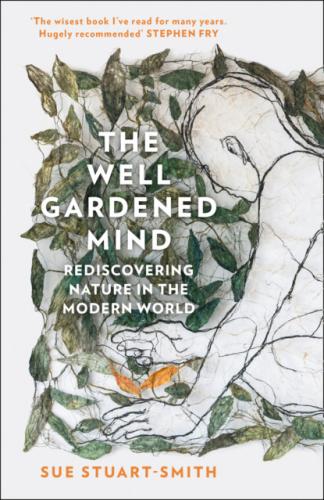THE WELL GARDENED MIND
Rediscovering Nature in the Modern World
Sue Stuart-Smith
William Collins
An imprint of HarperCollinsPublishers
1 London Bridge Street
London SE1 9GF
This eBook first published in Great Britain by William Collins in 2020
Copyright © Sue Stuart-Smith 2020
Cover illustration by Jaya Miceli
Sue Stuart-Smith asserts the moral right to be identified as the author of this work
A catalogue record for this book is available from the British Library
All rights reserved under International and Pan-American Copyright Conventions. By payment of the required fees, you have been granted the non-exclusive, non-transferable right to access and read the text of this e-book on-screen. No part of this text may be reproduced, transmitted, down-loaded, decompiled, reverse engineered, or stored in or introduced into any information storage and retrieval system, in any form or by any means, whether electronic or mechanical, now known or hereinafter invented, without the express written permission of HarperCollins
Source ISBN: 9780008100735
Ebook Edition © April 2020 ISBN: 9780008100728
Version: 2021-01-12
For Tom
‘All truly wise thoughts have been thought already thousands of times; but to make them truly ours, we must think them over again honestly, till they take root in our personal experience.’
Johann Wolfgang von Goethe
CONTENTS
Copyright
Dedication
Epigraph
1. Beginnings
2. Green Nature: Human Nature
3. Seeds and Self-Belief
4. Safe Green Space
5. Bringing Nature to the City
6. Roots
7. Flower Power
8. Radical Solutions
9. War and Gardening
10. The Last Season of Life
11. Garden Time
12. View From the Hospital
13. Green Fuse
Picture Section
Notes on Sources
Index
Acknowledgements
About the Author
About the Publisher
Come forth into the light of things,
Let Nature be your teacher.
William Wordsworth (1770–1850)
LONG BEFORE I wanted to be a psychiatrist, long before I had any inkling that gardening might play an important role in my life, I remember hearing the story of how my grandfather was restored after the First World War.
He was born Alfred Edward May, but was always known as Ted. Little more than a boy when he joined the Royal Navy, he trained as a Marconi wireless operator and became a submariner. In the spring of 1915 during the Gallipoli campaign, the submarine he was serving on ran aground in the Dardanelles. Most of the crew survived only to be taken prisoner. Ted kept a tiny diary in which he documented the early months of his captivity in Turkey but his subsequent time in a series of brutal labour camps is not recorded. The last of these was a cement factory on the shores of the Sea of Marmara, from which he eventually escaped by sea in 1918.
Ted was rescued and treated on a British hospital ship, where he recovered just enough strength to attempt the long journey home overland. Eager to be reunited with his fiancée, Fanny, whom he had left behind as a fit young man, he turned up on her doorstep in a battered old raincoat with a Turkish fez on his head. She barely recognised him for he weighed little more than six stone and had lost all of his hair. The 4,000-mile journey had, he told Fanny, been ‘horrendous’. When he underwent the naval medical examination, his malnutrition was found to be so advanced that he was given only a few months to live.
But Fanny nursed him faithfully, feeding him tiny amounts of soup and other sustenance on an hourly basis, so that gradually he was able to digest food again. Ted began the slow process of regaining his health and he and Fanny were married soon after. In that first year, he would sit for hours stroking his bald head with two soft brushes, willing his hair to grow back. When it finally did, it was prolific, but it was white.
Love and patient determination enabled Ted to defy the gloomy prognosis he had been given but his prison camp experiences stayed with him and his terrors were worst at night. He was especially afraid of spiders and crabs because they had crawled all over the prisoners as they tried to sleep. For years to come, he could not bear to be alone in the dark.
The next phase of Ted’s recovery began in 1920 when he signed up for a year-long course in horticulture, one of many initiatives set up in the postwar years with the aim of rehabilitating ex-servicemen who had been damaged by the war. After this he travelled to Canada, leaving Fanny at home. He went in search of new opportunities, in the hope that working the land might further improve his physical and mental strength. At that time the Canadian government was running programmes to encourage ex-servicemen to migrate and thousands of men who had returned from the war made that long Atlantic crossing.
Ted laboured on the wheat harvest in Winnipeg and then found more settled employment as a gardener on a cattle ranch in Alberta. Fanny joined him for some of the two years he spent there but for whatever reason their dream of starting a new life in Canada did not come to fruition. Nevertheless, Ted returned to England a stronger, fitter man.
A few years later, he and Fanny bought a smallholding in Hampshire where Ted kept pigs, bees and hens, and grew flowers, fruit and vegetables. For five years during the Second World War, he worked at the Admiralty wireless station in London; my mother remembers his pigskin suitcase, which travelled up with him on the train, packed full of home-slaughtered meat and home-grown vegetables. He and the suitcase would then return carrying
